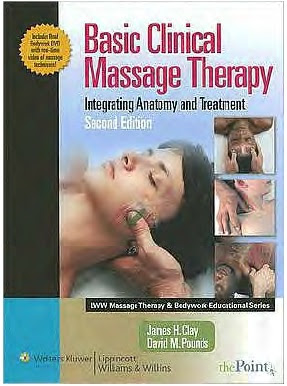Basic Clinical Massage Therapy PDF Ebook
-->
Basic Clinical Massage Therapy: Integrating Anatomy and Treatment is primarily a textbook for advanced
massage therapy students who have already acquired the basic skills of Swedish massage and are now pursuing
additional training in clinical massage therapy. In this book, I define â€oeclinical massage therapy― as the use
of manual manipulation of the soft tissues to relieve specific complaints of pain and dysfunction. As its title
implies, our book integrates detailed anatomical information with basic clinical massage therapy techniques. By
embedding illustrations of internal structures into photographs of live models, we are able to show exactly what
muscle is being worked on, where it is, where it is attached, how it can be accessed manually, what kinds of
problems it can cause, and one or more basic techniques for effectively treating it. The student can clearly see
the involved structures in relation to surrounding structures, surface landmarks, and the therapist's hands.
Therefore, this book offers a truly innovative visual and tactile understanding of anatomical spatial
relationships integrated with the learning of treatment techniques, which has not been possible with traditional
approaches.
Our approach is possible only through teamwork. Although I have had chief responsibility for the text and Dave
Pounds for the illustrations, we are truly co-authors, in that this project has been planned and executed by
both of us working closely together from its very inception. Vicki Overman, an outstanding photographer, has
worked with us in the first edition and shared our enthusiasm from the beginning. For the second edition, our
photography is by Black Horse Studio in Winston-Salem, North Carolina.
In addition to its use as a textbook, Basic Clinical Massage Therapy: Integrating Anatomy and Treatment can
also serve in the following roles:
A palpatory and muscle anatomy reference for practitioners. The anatomy of muscles and bones is
complex, and an accurate knowledge of it is essential to effective treatment. The practitioner must
have reliable reference sources to consult. In the past, practitioners have used atlases of anatomy
designed chiefly for surgeons. This book is tailored specifically to the needs of the clinical massage
therapist. By presenting the anatomy of muscles and bones in the context of the living human body, it
bridges the gap between internal muscular and external surface anatomy and allows students and
practitioners to see through the surface to the internal structures.
A client education tool. One of the biggest difficulties facing a therapist in dealing with clients is
explaining where a problem may lie, what structures may be involved, and what type of work is
proposed. Currently, practitioners must turn to traditional anatomy references, or to whole or partial
skeletons or other educational aids to make such explanations. The therapist can use this book to
present necessary information to clients in a way that is easily comprehensible.
New to This Edition
In addition to correcting a number of errata, we have received feedback from some school owners and
instructors, and have made the following additions and changes:
We have added a palpation entry for each muscle.
In addition to the references to the draping illustrations originally provided, we have added draping
to illustrations of therapy.
A custom DVD created by Real Bodywork (commissioned by the publisher) now accompanies the book,
containing real-time video clips of a number of massage sequences presented in the book.
Organization and Structure
This book is divided into two parts. Part I, Foundations of Clinical Massage Therapy, pre-sents essential
information about the basic principles on which clinical massage therapy is based. The first chapter explains the
place of clinical massage therapy in the health field and reviews the essentials about muscle structure and
function, body mechanics, basic techniques, and draping.
The second chapter is a guide to examination: interviewing, observation, photography, and palpation. It also
presents examples of forms to use and covers communication with physicians and other health professionals.
Part II, Approaching Treatment, constitutes the â€oemeat― of the book. We have organized the chapters in
this part into body regions that have functional, topographical, and clinical coherence. These regions are:
head, face, and neck
shoulder, chest, and upper back
arm and hand
vertebral column
low back and abdomen
pelvis
thigh
leg, ankle, and foot
Each Part II chapter has the same internal structure. This rigorous internal consistency is deliberate: Learning is
based on repetition, and a repetitive organization allows the reader to more easily process and internalize
information. Each chapter, therefore, has the following components:
Overview of the Region. Here, we review the muscular and skeletal components of the region under
discussion, and offer observations on conditions that typically cause pain and dysfunction in that
region. Extensive anatomy plates, presented in a horizontal (â€oelandscape―) format, depict in
detail the internal anatomy. Labels point out each pertinent structure and are keyed to the text
discussion.
Muscle Sections. Each muscle of that region is then discussed. These sections are distinguished by
their use of various icons that highlight key pieces of information.
Pronunciation. As communication between massage therapists and other members of the health care
community continues to increase, it is important to know how to pronounce each muscle name
correctly. We use a phonetic pronunciation key that is easy to decipher.
Etymology. A brief derivation of each muscle name is given. Etymologies are extremely helpful in
learning and remembering anatomical structures.
Overview. Here, we give a succinct but thorough overview of the structure and function of the
muscle. We also review potential causes of pain and dysfunction that may affect the muscle.
Comments. Where appropriate, interesting or esoteric comments about the muscle are included. For
instance, we point out that biceps brachii resides on the humerus but has no attachments to it, and
that in addition to being a flexor it is the most powerful supinator of the forearm.
download plese click here
download plese click here


